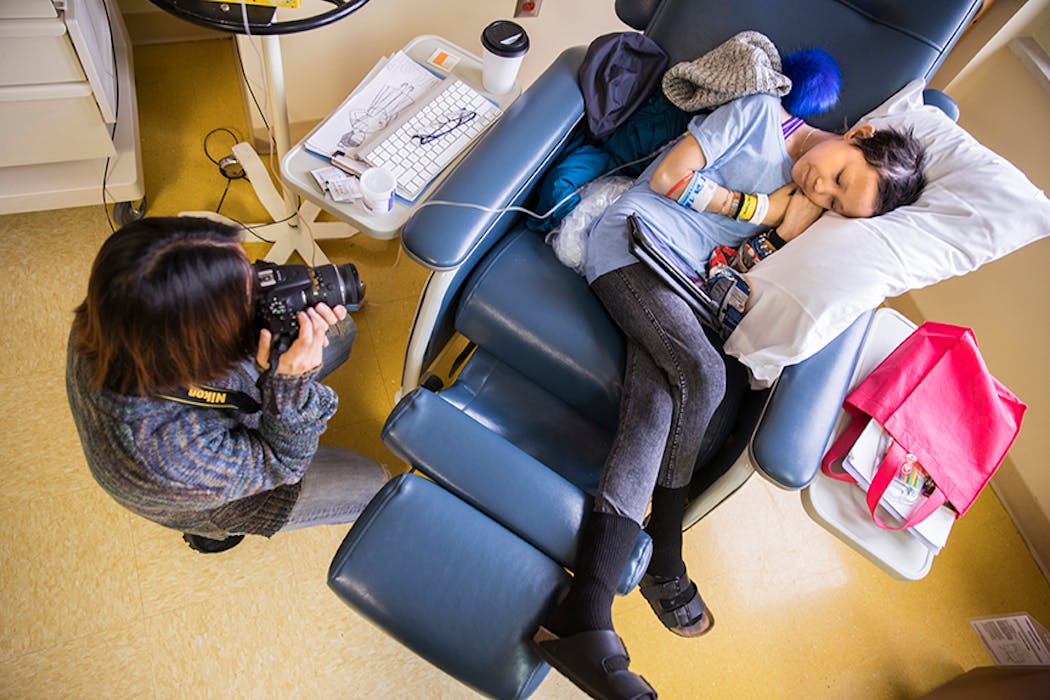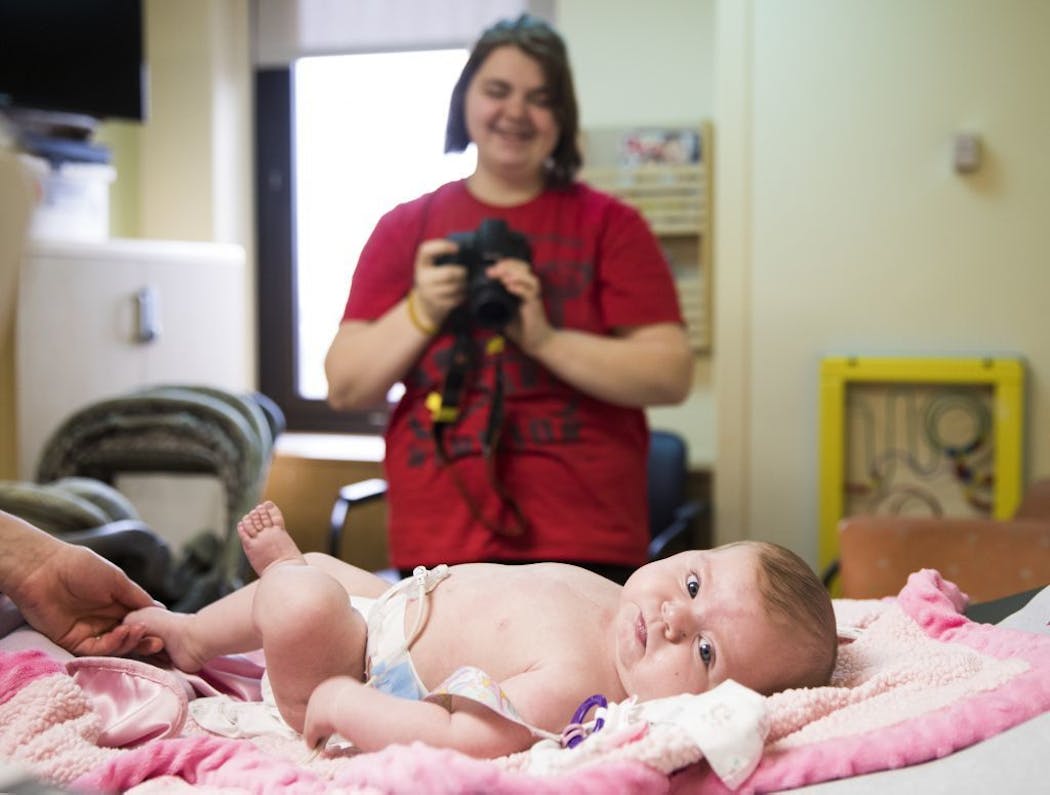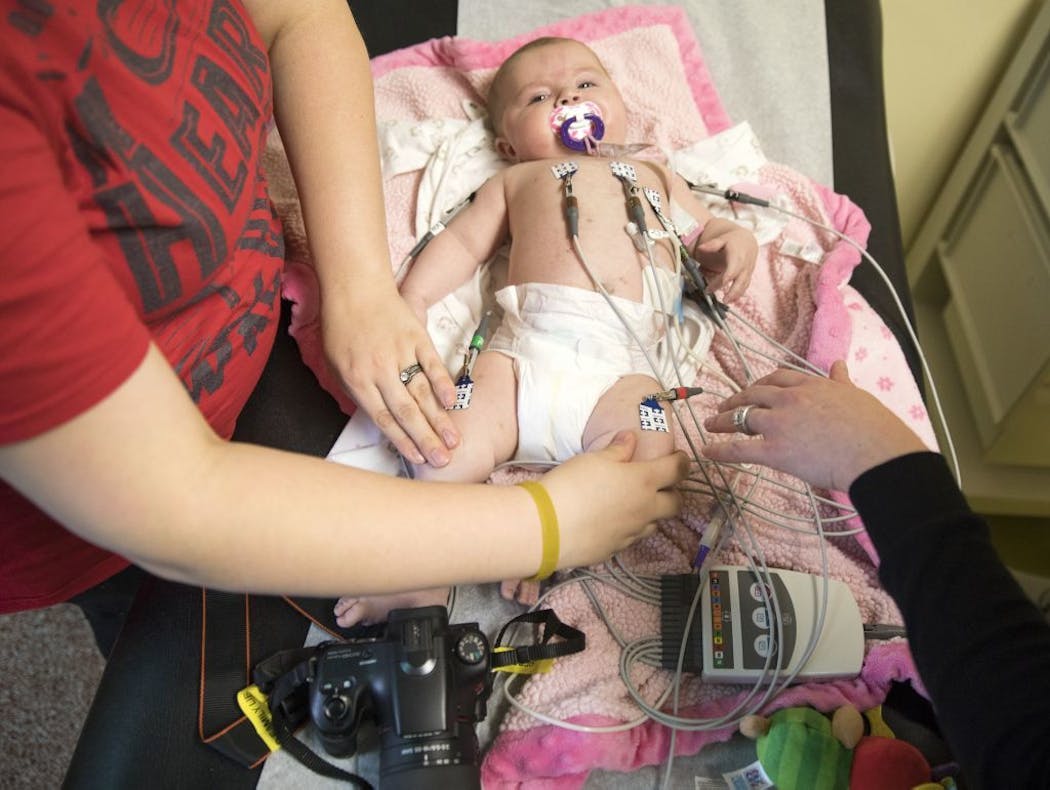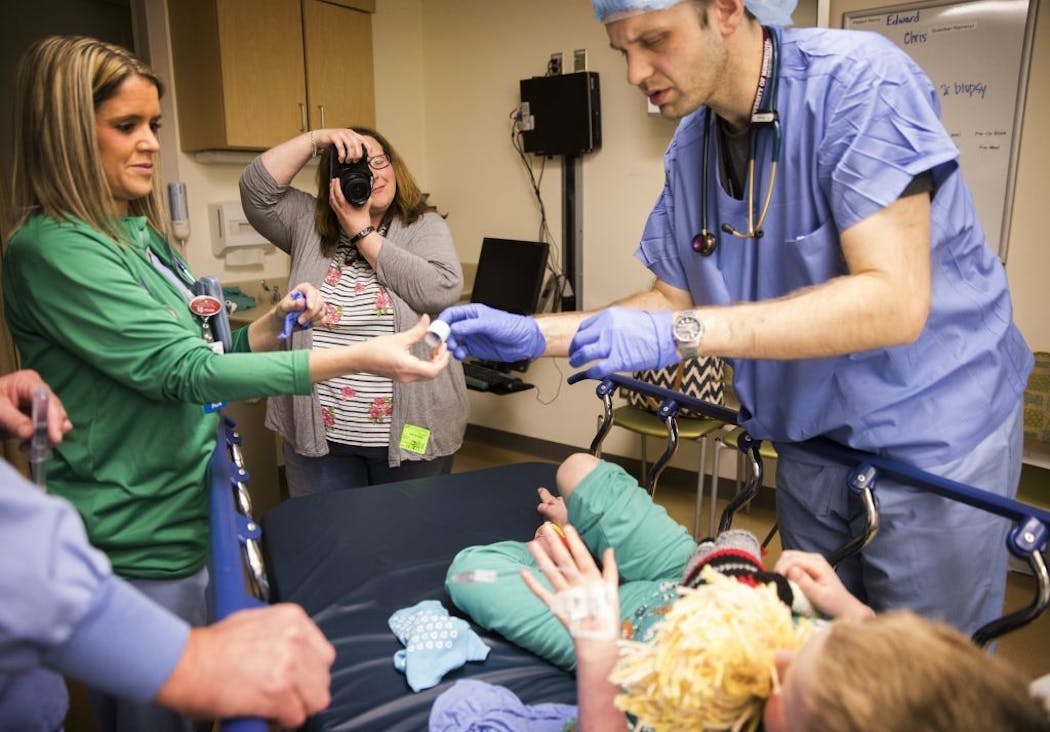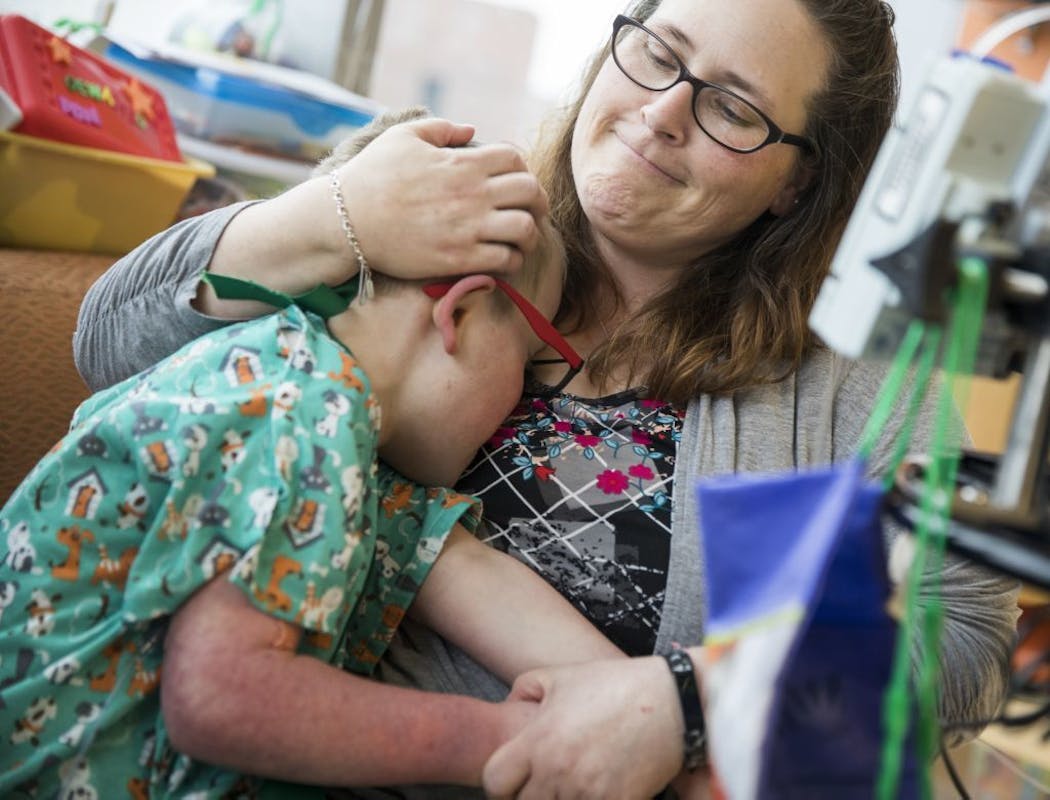The idea began as a nice gesture for parents of children hospitalized with serious conditions, not for days, but for months.
So much waiting, so much stress. Maybe teach them some photography skills to fill the time?
Hospitals long have valued photos in their treatments, says Ashley Wunderlich, child-life specialist at the University of Minnesota Masonic Children's Hospital in Minneapolis.
On the day of an organ transplant, or when a milestone is achieved, or when the end of life nears, staff or professionals may document a moment. This time, though, the hospital wanted to put cameras into parents' hands.
Jim Bovin, a former newspaper photographer who's worked for the hospital over the years, said he'd share his expertise. Again, a nice thing to do. But Bovin and Wunderlich soon noticed something.
"We saw that there was a therapeutic value to them taking these photos," Wunderlich says. The nice gesture became a grant-funded project called Perspectives. Its second year ended with a private photo exhibition in February. So far, Bovin has collected and is editing more than 13,000 images from seven families.
The resulting photos aren't about pivotal events as much as about everyday life. They capture mundane moments, quicksilver smiles, impulsive pranks, knuckled-away tears.
And true to the cliché, a picture can convey what might take a thousand words to describe.
"Storytelling can be so therapeutic for helping families process what's happening," Wunderlich says. "But when they have to tell their stories so often, it's no longer therapeutic."
Bovin agrees: "I tell families, 'There are days when you won't want to talk, but you can show this visually.' "
From what Wunderlich can gather, the project may be the only one of its kind in which parents document life specific to the hospital experience. In May, she'll present what they've learned at the Child Life Annual Conference in Maryland.
In many ways, the project accomplishes its original goal. Bovin teaches parents about perspective and focus and shutter speed, about how to frame long shots and close-ups. He coaches them on considering the emotion they seek to capture, the story they're trying to tell.
"Bottom line, the whole project comes down to feeling," he says, then pulled up one of his favorite photos of Corah Ohlquist, an infant with a congenital heart defect.
Chelsee Ohlquist caught an endearing moment of her husband, Jeremy, reclining on the hospital bed with Corah perched on his stomach.
"You have these groundbreaking treatments going on all around you, but what does life here actually look like?" he asks. "It looks like a daughter hooked up to an IV drip, sitting on her dad's chest."
The Ohlquists
Holding a camera helps Chelsee Ohlquist cope when the enormity of what is happening to her baby girl looms too large.
Like the time when lab technicians were trying to draw some blood from Corah, who was born with congenital heart disease.
"She'd had so many, so they were trying to find a place that wasn't so hard to go into and they decided to try her head," Ohlquist says. "I took photos since I couldn't do anything else. And it got me past the sight of them poking my daughter in the head. I could hide behind the camera."
Ohlquist, who lives in International Falls, says she's always wanted to be a photographer and, as "more of an old-fashioned person," loves black-and-white photos.
Hospital life also was a terribly familiar routine; their older daughter, Emmah, came to Masonic Children's Hospital when she was diagnosed with neuroblastoma cancer as an infant. She's now 3, and the experience impressed upon Ohlquist that treatment is a story "with a lot of layers."
"In the harder times, it lowers my stress to concentrate on lighting or focus," she says of the skills she's learning from Jim Bovin of the Perspectives project. "And it feels nice to get a compliment from him."
She exhaled. The project is understandably — and literally — focused on the patient, but it also addresses how crucial it is for caregivers to feel cared for.
"Deep down, it feels awesome to get compliments," Ohlquist says. "Growing up, I was always pushed to do something better and better, yet never got to the point of getting compliments. So it really makes me feel good."
Documenting Corah's treatments also creates a record of those times when life becomes a blur between home, hospital and the Ronald McDonald House, where they stay when in Minneapolis.
"It's crazy to see how far we've come," she says.
Ohlquist's photos also serve to document the dizzying cast of medical professionals.
"One thing I like about the photos it that you get to see the nurses do their jobs," she says. "I mean, everyone knows that doctors save lives.
"But the nurses do, too."
The Kunzes
It's difficult to grasp how surreal 2017 was for Chris Kunze and her son Eddie.
From Jan. 9 to Dec. 5, they lived at the hospital, sharing a room as 9-year-old Eddie awaited a donor for a heart transplant, an inevitable surgery after he was born with hypoplastic left heart syndrome.
"That means the left side of his heart just never developed," says his mother, who divided her time as much as possible between the hospital and her home in Buffalo with four older children, ages 15 to 24.
"At first you go into every day thinking, 'This could be the day,' " she says of the wait. "Then, 'OK, this wasn't the day.' Then after a while, you stop doing that."
Taking photos could prompt a similar thought process.
"You hesitate sometimes," Kunze says. "You think, 'Do you want to see this? Do you want to look back on this?' "
Yet she almost always took the photo, mostly because thinking of the future gave her some respite from the present.
"I knew I could look at it later and not really have to focus on it now," she says of certain moments. "Then I can explain to Ed, who won't have a memory of so many things, thank God.
"If I let the incredible overwhelmingness of what we're doing here become clear to him, then we're all going down."
One such photo shows the empty hospital room from which Eddie was wheeled into surgery in December. Kunze had taken more than 2,000 photos, but knew that this possibly could be her last.
Happily, more photos followed — of recovery and going home and checkups.
And there were hilarious photos, such as during the change of an IV drip. The nurse had a two-minute window in which to reinsert a fresh IV. Eddie had always stood still.
"But one time, he took off, ran around the bed, did a little dance and said, 'I'm free!' " says Kunze, who clicked precisely at the gleeful moment. His "escape" actually helped hospital staff understand that if there's time for a bit of untethered running about, even if only for two minutes, let it happen.
"That one thing kept me going through all of this," she says. "Maybe doctors and staff can learn something."
The Hawleys
Katy Hawley had always taken photos of her daughter Nathalia, sometimes framing her against the backdrop of Lake Superior.
"She's always been my muse, my model," said Hawley, who lives in Duluth. "But I'd take photos with my really crappy phone."
So the Perspectives project's offer to use a proper camera was a gift, because she knew that she and Nat had a story to tell.
"There are people who are really good with words," Hawley said. "Me, not so much. But I need people to see that this is our reality."
Nat, now 14, was in sixth grade when she was diagnosed with osteosarcoma. The bone cancer already had metastasized, spreading to her lungs.
After removal of part of her femur, a knee replacement and two lung surgeries, Nat showed no evidence of cancer until late last year, when doctors found a lump near her pelvis.
For Hawley, the photos help preserve Nat's identity as a teenager, not just as someone with cancer.
"Yeah, she doesn't have hair, but she's doing things she's always done — putting on makeup or doing art," she said. "She's still her."
At first, she added, Nat was hesitant about documenting her hospital stays, but decided that it would be good to be able to look back on the photos.
"It'll help us all remember."
Hawley hasn't relied on the camera for every memory.
"Sometimes I have to be in that moment, just mentally take a picture of it," she said. "But with the camera, I'm thinking, 'What would I want to see? What do I want people to feel? And not in a bad way, but just to make them pause."
The photos also help Nat's 10-year-old sister cope. "When she can see things, she feels safer," Hawley said.
Nat's treatments continue. "But it gets easier in a way, because you've been disappointed so much," Hawley said. "I celebrate the successes, but I never let my guard down. Still, I want to show people that cancer isn't scary, that it's a journey."
She likes black-and-white photos, favoring them over the distraction of colors.
"There is some beauty in the dark."
